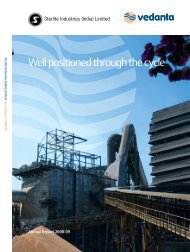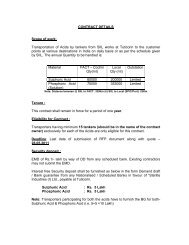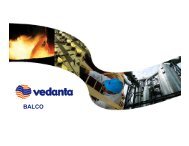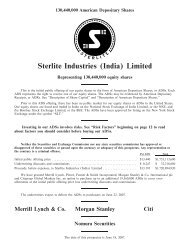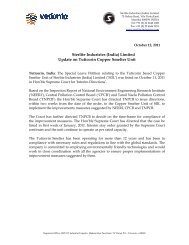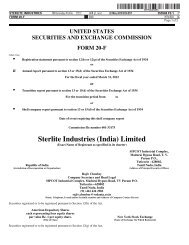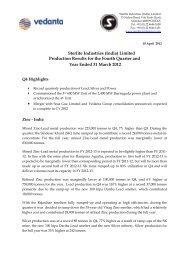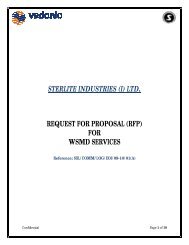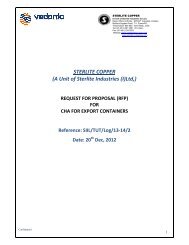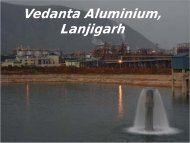Sterlite Industries (India) Limited - Sterlite Industries India Ltd.
Sterlite Industries (India) Limited - Sterlite Industries India Ltd.
Sterlite Industries (India) Limited - Sterlite Industries India Ltd.
You also want an ePaper? Increase the reach of your titles
YUMPU automatically turns print PDFs into web optimized ePapers that Google loves.
Additional Supply of Alumina<br />
The additional alumina required for BALCO’s smelters in excess of the capacity of its alumina refinery is obtained by purchasing alumina<br />
on both the domestic <strong>India</strong>n market, including from Vedanta Aluminium, and international markets. Alumina purchased from third party<br />
suppliers is transported by road to BALCO’s smelters at Korba. In addition, BALCO also sends bauxite to Vedanta Aluminium for conversion<br />
into alumina, which is returned to BALCO for use in its smelters, for which a conversion fee linked to market rates is paid to Vedanta<br />
Aluminium.<br />
Aluminum Smelters<br />
BALCO’s 245,000 tpa aluminum smelter uses pre-baked technology from GAMI of China. In this pre-baked process, alumina is converted<br />
into primary aluminum through a smelting process using electrolytic reduction. The reduction process takes place in a reduction cell, referred to<br />
as the pot, where alumina is reduced to molten aluminum. From the pot-line, the molten aluminum is sent to the fabrication facility.<br />
During fiscal 2009 and until June 5, 2009, BALCO also operated a 100,000 tpa aluminum smelter that uses Vertical Stud Soderberg, or<br />
VSS, technology to produce aluminum from alumina. Alumina is dissolved in an electrolytic bath of molten cryolite (sodium aluminum<br />
fluoride) in a large carbon or graphite lined steel container known as a “pot.” An electric current is passed through the electrolyte at low voltage<br />
but at a very high current. The electric current flows between a carbon anode (positive), made of petroleum coke and pitch, and a cathode<br />
(negative), formed by the thick carbon or graphite lining of the pot. Molten aluminum is deposited at the bottom of the pot and is siphoned off<br />
periodically. The molten aluminum is then taken to a holding furnace, cleaned and sent to the fabrication facility. In response to recent global<br />
economic conditions and a decline in commodity prices, starting in February 2009, BALCO suspended part of its operations at the 100,000 tpa<br />
aluminum smelter. Operations at this aluminum smelter ceased on June 5, 2009. The surplus power generated by the captive power plants at the<br />
Korba facility is sold to the CSEB and other third parties.<br />
Fabrication Facility<br />
BALCO’s fabrication facility, consisting of a cast house and a sheet rolling shop, processes the molten aluminum from the smelters into<br />
ingots, wire rods and rolled products. The cast house uses continuous rod casters from Continuus-Properzi S.p.A. and has a foundry which has<br />
twin-roll continuous casters with a spinning nozzle inert flotation, or SNIF, degasser and hydraulically driven semi-continuous ingot casting<br />
machine to produce ingots and wire rods. Molten metal is cast into slabs and either hot-rolled and sold as hot-rolled sheets or converted into<br />
cold-rolled sheets in the cold rolling mills. Alternatively, molten metal is directly used in strip casting and then fed to the cold rolling mills to<br />
convert it into cold-rolled sheets or coils.<br />
Delivery to Customers<br />
Ingots, wire rods and rolled products are transported by trucks to customers in <strong>India</strong> and to ports for export.<br />
46



